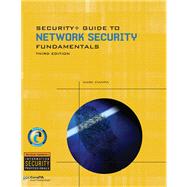
Note: Supplemental materials are not guaranteed with Rental or Used book purchases.
Purchase Benefits
What is included with this book?
| Introduction to Security | |
| Challenges of Securing Information | |
| Today+s security attacks | |
| Difficulties in defending against attacks | |
| What Is Information Security? | |
| Defining information security | |
| Information security terminology | |
| Understanding the importance of information security | |
| Preventing data theft | |
| Thwarting Identity Theft | |
| Avoiding legal consequences | |
| Maintaining Productivity | |
| Foiling Cyberterrorism | |
| Who Are the Attackers? | |
| Hackers | |
| Script Kiddies | |
| Spies | |
| Employees | |
| Cybercriminals | |
| Cyberterrorists | |
| Attacks and Defenses | |
| Steps of an attack | |
| Defenses against attacks | |
| Layering | |
| Limiting | |
| Diversity | |
| Obscurity | |
| Simplicity | |
| Surveying Information Security Careers and the CompTIA Security+ Certification | |
| System Threats and Risks | |
| Software-Based Attacks {1.1) | |
| Infecting Malware | |
| Viruses (1.1) | |
| Worms (1.1) | |
| Concealing Malware | |
| Trojan Horses (1.1) | |
| Rootkits (1.1) | |
| Logic Bombs (1.1) | |
| Privilege escalation (1.1) | |
| Profiting Malware | |
| Spam (1.1) | |
| Spyware (1.1) | |
| Adware (1.1) | |
| Keyloggers | |
| Botnets (1.1) | |
| Hardware Attacks {1.2} | |
| BIOS (1.2) | |
| USB devices (1.2) | |
| Removable storage (1.2) | |
| Network attached storage (1.2) | |
| Cell phones (1.2) | |
| Attacks on Virtualized Systems (1.6) | |
| What is virtualization? | |
| Attacks on virtual systems | |
| Protecting Systems | |
| Hardening the Operating System {1.3} | |
| Managing operating system updates | |
| Hot fixes (1.3) | |
| Service packs (1.3) | |
| Patches (1.3) | |
| Patch management techniques (1.3) | |
| Protecting the operating system through procedures | |
| Group policies (1.3) | |
| Security templates (1.3) | |
| Configuration baselines (1.3) | |
| Managing Application Security | |
| Protecting the web browser (1.4) | |
| ActiveX (1.4) | |
| Java (1.4) | |
| Scripting (1.4) | |
| Cookies (1.4) | |
| Input validation (1.4) | |
| Cross-site scripting (1.4) | |
| Protecting communication applications | |
| Buffer overflows (1.4) | |
| SMTP open relays (1.4) | |
| Instant messaging (1.4) | |
| P2P (1.4) | |
| Applying System Security Applications | |
| Host Intrusion Detection Systems (HIDS) (1.5) | |
| Personal software firewalls (1.5) | |
| Antivirus (1.5) iv. Anti-Spam (1.5) v. Popup blockers (1.5) NETWORK SECURITY | |
| Network Vulnerabilities and Attacks | |
| Liabilities in Networks | |
| Media Liabilities | |
| Vampire taps (2.6) | |
| Cable placement | |
| Wireless Network Liabilities | |
| Data emanation (2.7) | |
| SSID broadcast (2.7) | |
| Weak encryption (2.7) | |
| Attacks on Networks | |
| Protocol-based attacks {2.1} | |
| Antiquated protocols (2.1) | |
| DNS poisoning (2.1) | |
| ARP Poisoning (2.1) | |
| Impersonation attacks | |
| TCP/IP hijacking (2.1) | |
| Spoofing (2.1) | |
| Man in the middle (2.1) | |
| Replay (2.1) | |
| Wireless attacks | |
| War driving (2.7) | |
| Blue jacking (2.7) | |
| Blue snarfing (2.7) | |
| Rogue access points (2.7) iv. Other attacks {2.1} | |
| Null sessions (2.1) | |
| DOS (2.1) | |
| DDOS (2.1) | |
| Kiting (2.1) | |
| Network Defenses | |
| Creating a Secure Network | |
| Security through network technologies | |
| Network Address Translation (NAT) (2.2) | |
| Network Access Control (NAC) (2.2) | |
| Security through network design | |
| Demilitarized zones (DMZ) (2.2) | |
| Virtual LAN (VLAN) (2.2) | |
| Virtual private network | |
| Subnetting (2.2) | |
| Network interconnections (2.2) | |
| Convergence [? CompTIA has +Telephony+] (2.2) | |
| Network Device Vulnerabilities {2.5} | |
| Privilege escalation (2.5) | |
| Weak passwords (2.5) | |
| Back doors (2.5) | |
| Def | |
| Table of Contents provided by Publisher. All Rights Reserved. |
The New copy of this book will include any supplemental materials advertised. Please check the title of the book to determine if it should include any access cards, study guides, lab manuals, CDs, etc.
The Used, Rental and eBook copies of this book are not guaranteed to include any supplemental materials. Typically, only the book itself is included. This is true even if the title states it includes any access cards, study guides, lab manuals, CDs, etc.